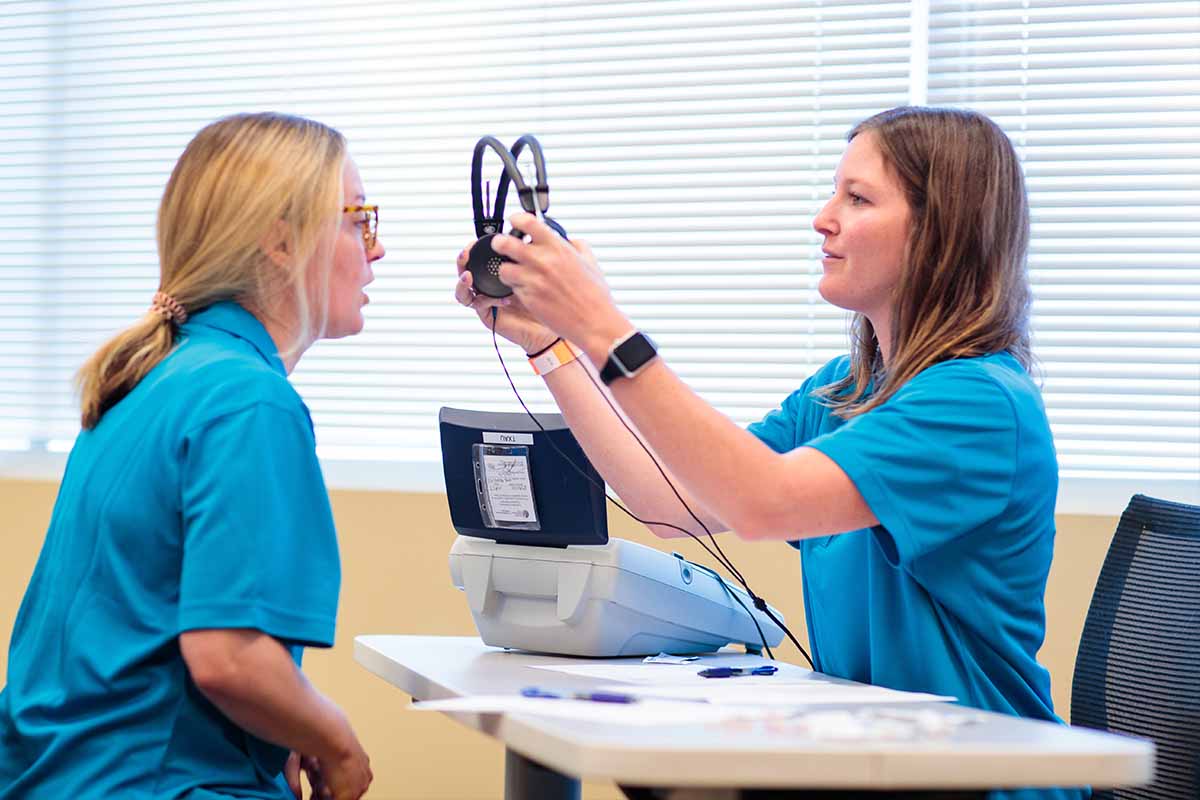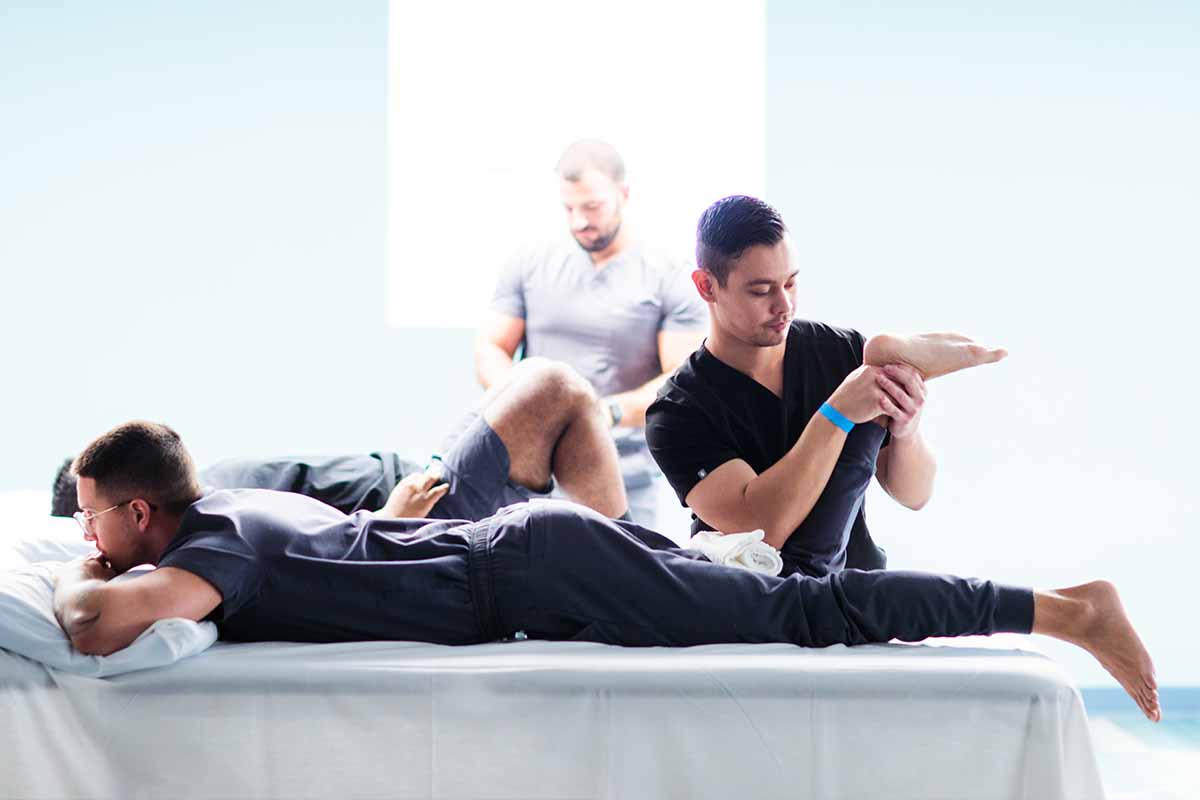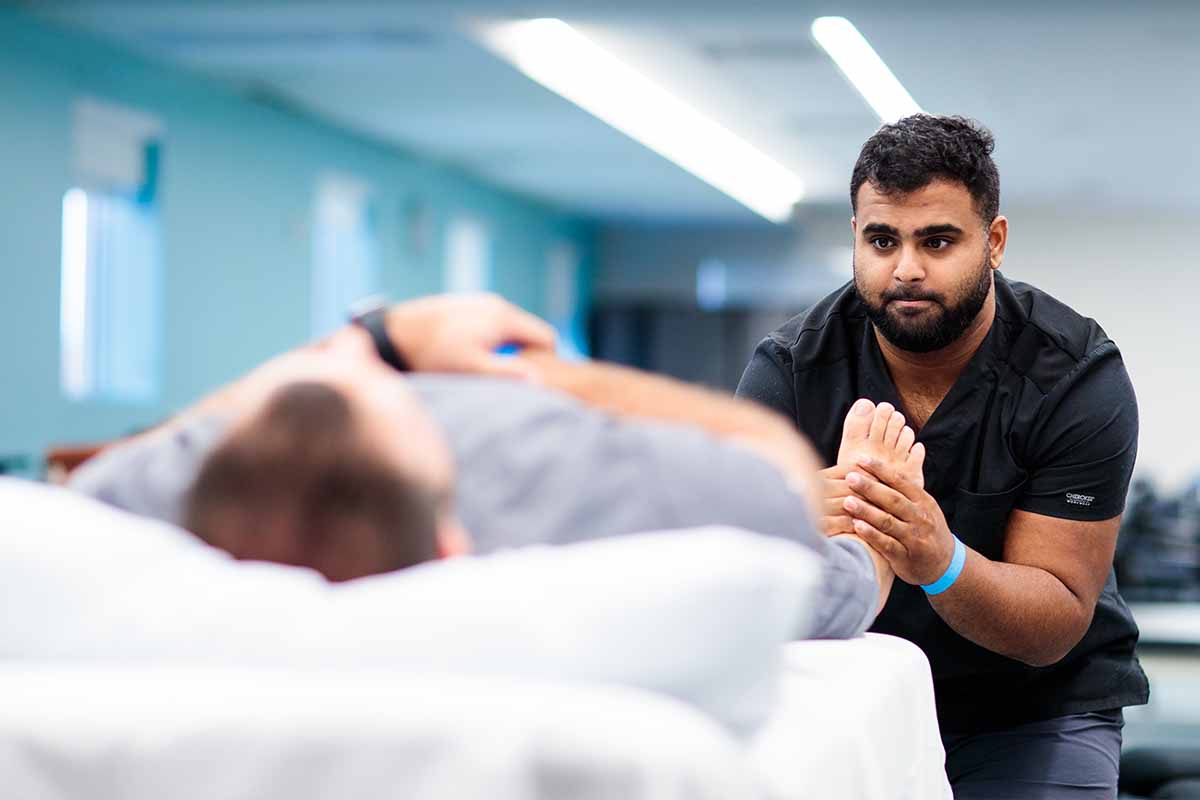USAHS Faculty Leverage Telehealth in Virtual Classroom and Clinical Settings
During the COVID-19 pandemic, telehealth has come to the forefront as a mode of treatment delivery for practitioners in the rehabilitative sciences: physical therapists, occupational therapists, and speech-language pathologists. Barriers such as regulatory and reimbursement issues were relaxed by the CARES Act,[1] and many patients and providers have learned the technology by necessity. At USAHS, where we specialize in the rehabilitative and health sciences, faculty are now leveraging telehealth as a mode of teaching—as well as a mode of treating patients in their clinical practice.
Telehealth in Teaching
Adapting a clinical course to a telehealth simulation
Dr. Kristy Demers, PT, DPT, is an instructor in the Doctor of Physical Therapy (DPT) program on USAHS’s Austin campus. She teaches the fifth-trimester course Patient Care Management III, in which students evaluate the pathophysiologies of simulated patients. “The whole course normally takes place in the CICP,” Dr. Demers says, referring to the University’s Centers for Innovative Clinical Practice. “So when stay-at-home orders came down due to COVID-19, we had to get really creative.” She and her colleagues across USAHS campuses collaborated to transition this clinical course to an online course that simulates telehealth.
Over videoconference, students take the subjective history of the mock patient, a role now played by faculty members. Based on this information, they perform remote movement testing, create a treatment plan, and teach exercises to the patient. Students then discuss what additional interventions, tests, and measures they would perform if they were in the clinic. “It has forced students to think outside the box,” Dr. Demers says.
Teaching with Our Telehealth Technology
A technological innovation is helping our students prepare to treat patients via telehealth. Each USAHS campus now has a Double 3 telepresence robot from Double Robotics in its simulation center. A remote healthcare provider can communicate with a patient or team member through a movable robot that provides a human-like virtual presence through a screen. The provider can maneuver the robot around the patient and can ask the patient to move, so they can assess movement and mobility.
Assistant professor Kelly Layne, OTD, MOT, launched a pilot in 2019 in the Clinical Applications in Geriatrics course on our St. Augustine, Florida campus. Students participate in a simulation scenario in which they consult on the treatment of a mock client with an expert who is remoting in through the Double robot.
Training Other Practitioners on Telehealth
Dr. Becki Cohill, coordinator of the Doctor of Occupational Therapy program on the San Marcos campus, recently trained over one thousand rehabilitative practitioners—occupational therapists, physical therapists, and speech-language pathologists—on best practices in telehealth.
Dr. Cohill had served on a State of Colorado task force to change legislation around telehealth and develop strategies for treating young children in underserved populations using this model. When COVID-19 hit, she saw the need to train her colleagues in delivering therapy through telehealth. She partnered with her former student, Leah Foreman, OTD ’19, to create a training program.
Drs. Cohill and Foreman led virtual Q&A sessions covering topics such as how to deliver interventions through the coaching model; how to empower parents to help their child reach goals; and how to navigate HIPAA, licensing, and billing issues.
“Telehealth is not for every family or every child,” Dr. Cohill says. “But when it works, the outcomes are the same or even better than for in-person services. We often see an acceleration of the child’s progress when we use telehealth as a service delivery model—the parents’ participation in the therapy process makes the difference. You teach parents strategies and how to identify the changes in their child’s development, and they can carry that throughout the day in their own routines and environment. Then the therapy program doesn’t feel like work.”
She notes that in response to the pandemic, the American Occupational Therapy Association (AOTA) has created excellent free training about delivering OT through telehealth.
Using Telehealth in Clinical Rehab Settings
Occupational Therapy and Telehealth
Maureen Fischer, OTR/L, is a lab assistant in the Clinical Applications in Pediatrics/Adolescence class on our campus in St. Augustine, Florida. She works for an agency that contracts with the Jacksonville School for Autism. When the pandemic hit, the agency moved to doing teletherapy with the students and their families.
Challenges: “The hardest part is not to be hands-on,” Fischer says. It was also difficult at first to get her younger patients to focus on telehealth. However, she says they’re getting used to it now—and learning participation skills in the process.
Opportunities: “You can see the layout of the house, the tools they use, how kids are navigating their home environment, what their family life is like,” Fischer says. “With ADL [activities of daily living] tasks that are challenging, you can walk them through the movements in their home environment. And it’s possible to collaborate more with parents and teach them hands-on interventions.”
Tips: Fischer emails the parent in advance and asks them to prepare a dedicated workspace with certain tools or toys. She has several activities ready to go, so that in case the child doesn’t engage with one, she can move on to the next. If the child gets overloaded, they can practice taking a “sensory break.”
The future of OT and telehealth: Fischer says that even before the pandemic, telehealth was becoming more popular in OT. “Anecdotally, it seems more common in pediatric settings,” she says. “Adults who need OT typically have physical disabilities, so hands-on work in a clinic is more important for them.” Once schools reopen, telehealth could remain a useful tool for doing periodic check-ins with parents, she says.
Physical Therapy and Telehealth
Dr. Demers, the DPT instructor who is transitioning the clinical course to online, spoke to us about treating PT patients through telehealth.
Challenges: “Obviously, you can’t do manual physical therapy techniques through telehealth,” she says. “Also, you can’t perform certain hands-on tests and measures.”
Opportunities: Instead of getting into the nitty-gritty, the PT must focus on the big picture of the patient’s health—which is also important, she notes. And it’s helpful to see the setup of the patient’s home, such as the stairs and the kitchen.
Tips: Regulations and billing rules are relaxed and changing on a weekly basis, Dr. Demers says, so it’s important to keep abreast of changes. She notes that telehealth works best with PT patients who have some technical literacy, who are not a fall risk, and who have progressed well after an acute/subacute injury so that educational and exercised-based interventions are sufficient. Telehealth is also a good option for those who need PT from a specialist in a different city.
The future of PT and telehealth: “Telehealth is not a replacement for PT in the clinic, but it can be a good adjunct,” she says. “For example, you could do once a week in the clinic, once a week telehealth, though we need studies on its effectiveness.”
From speaking to colleagues in the Austin physical therapy community, her impression is that many clinics had telehealth technology installed but had not implemented it before COVID-19. Now, some of her telehealth-ready peers are using it, while other clinics have temporarily closed.
“The country and the profession are going through such a hard time,” says Dr. Demers. “My hope is that this pause will give us the time and the relaxed regulations we need to set [PT and telehealth] up. Patients who wouldn’t walk into a physical therapy clinic now have more availability to PT. It could be a really valuable opportunity to expand what we do across society.”
Speech-Language Pathology and Telehealth
Ana Rivera, PhD, CCC-SLP, is a faculty member in the Master of Science in Speech-Language Pathology program on the Dallas campus. She has experience with teletherapy and has trained colleagues to use this mode. She works part-time at an interprofessional rehabilitation office that has transitioned to teletherapy during the pandemic. There, she treats children ages 1–8 with autism, Down syndrome, and speech delays.
Challenges: Most of the younger children whom Dr. Rivera works with have trouble sitting still, and it can be taxing for parents to try to make them focus. “I would not recommend ongoing teletherapy for infants and toddlers with autism,” she says. “They need the in-person contact, and they get too much visual stimulation from the screen.” She says that teletherapy works better for older kids and adults, but more research is needed on its effectiveness.
Opportunities: “The benefit of online therapy is that the parents are more involved,” Dr. Rivera says. “You can show the parents and kids how to use their own toys for language and speech therapy.” She notes that Zoom has a built-in mirror of sorts: the child can see the therapist’s face and their own face at the same time, so they can mimic what Dr. Rivera is doing with her mouth. She can share her screen and enable children to play with interactive materials such as Boom Learning’s Boom Cards.
Tips: “Watch YouTube videos about how to use electronic tools for speech therapy over telehealth for fresh ideas,” Dr. Rivera suggests. “Choose materials that are interactive and closely mimic what you would do in a clinical setting. Teach the client how to receive treatment through teletherapy, like using the computer mouse. Choose a platform that allows for interactivity, such as the HIPAA-compliant version of Zoom.”
Along with using Boom Cards, Dr. Rivera makes her own manipulable online games. She says some speech-language pathologists (SLPs) have made materials available for free during the pandemic, and Teachers Pay Teachers has material specifically for teleservices.
The future of SLP and telehealth: “It’s good that people are becoming more comfortable with telehealth,” she says. “I hope that new research is being conducted on how it’s working for best practices and outcomes. To my knowledge, there is no standard protocol for SLPs in telehealth yet, but it’s an exciting area for further study.”
[1] Sarah Beth Kuyers and Ellen Janos, “Barriers to Telehealth Continue to Fall After CARES Act and Other Federal and State Actions,” National Law Review, April 3, 2020: https://www.natlawreview.com/article/barriers-to-telehealth-continue-to-fall-after-cares-act-and-other-federal-and-state











